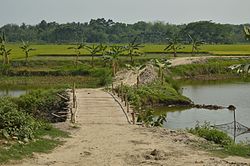Population
As per 2011 Census of India Baduria CD Block had a total population of 285,319, of which 278,044 were rural and 7,275 were urban. There were 145,641 (51%) males and 139,678 (49%) females. Population below 6 years was 31,920. Scheduled Castes numbered 46,811 (16.41%) and Scheduled Tribes numbered 2,423 (0.85%). [7]
As per 2001 census, Baduria block has a total population of 247,592 out of which 125,290 were males and 121,302 were females. [8]
There is only one census town in Baduria CD Block (2011 census figure in brackets) : Dakshin Chatra (7,275). [7]
Large villages in Baduria CD Block (2011 census figures in brackets): Ghoshpur (7,036), Salua (4,237), Chandipur (11,021), Bagjola (4,134), Bena (5,702), Ramchandrapur (5,650), Kankrasuti (5,345), Atghara (5,250), Haidarpur (4,098), Shimla Durgapur (7,225), Jashaikati (7,317), Narayanpur (4,116), Jangalpur (4,917), Serpur (4,874), Jadurhati Khaspur (4,016), Gokna (4,455), Maleapur (4,318), Fatullapur (4,589), Punra (P) (8,590), Gandharbbapur (5,038), Piyara (4,957), Katia (6,450), Aturia (7,182) and Sayestanagar (7,014). [7]
North 24 Parganas district is densely populated, mainly because of the influx of refugees from East Pakistan (later Bangladesh). With a density of population of 2,182 per km2 in 1971, it was 3rd in terms of density per km2 in West Bengal after Kolkata and Howrah, and 20th in India. [9] According to the District Human Development Report: North 24 Parganas, "High density is also explained partly by the rapid growth of urbanization in the district. In 1991, the percentage of urban population in the district has been 51.23." [10]
Decadal Population Growth Rate (%)
The decadal growth of population in Baduria CD Block in 2001-2011 was 15.22%. [11] The decadal growth of population in Baduria CD Block in 1991-2001 was 17.17%. [12]
The decadal growth rate of population in North 24 Parganas district was as follows: 47.9% in 1951-61, 34.5% in 1961-71, 31.4% in 1971-81, 31.7% in 1981-91, 22.7% in 1991-2001 and 12.0% in 2001-11. [13] The decadal growth rate for West Bengal in 2001-11 was 13.93%. [14] The decadal growth rate for West Bengal was 17.84% in 1991-2001, 24.73% in 1981-1991 and 23.17% in 1971-1981. [15]
Only a small portion of the border with Bangladesh has been fenced and it is popularly referred to as a porous border. It is freely used by Bangladeshi infiltrators, terrorists, smugglers, criminals et al. [16] [17] [18] [19]





















